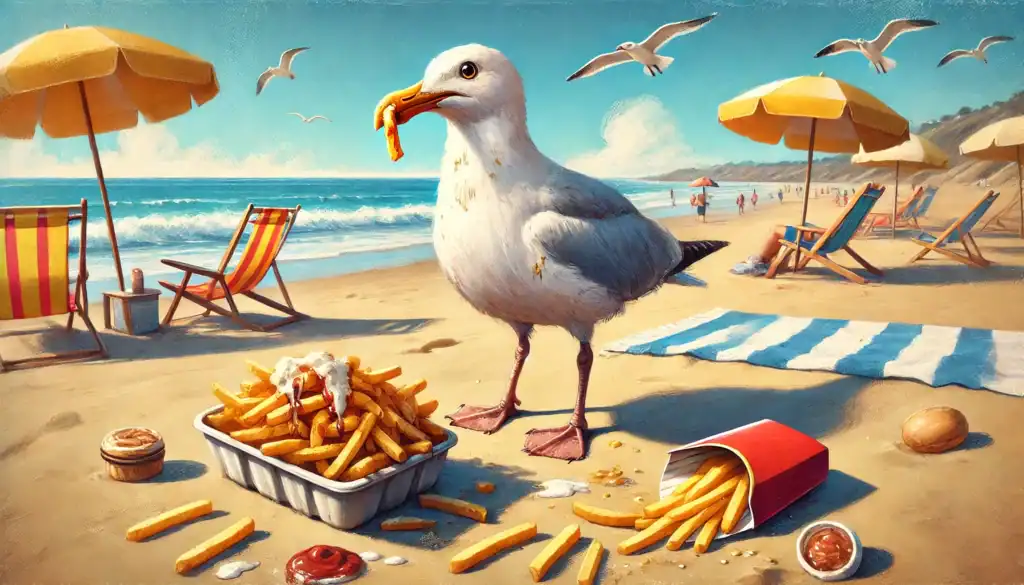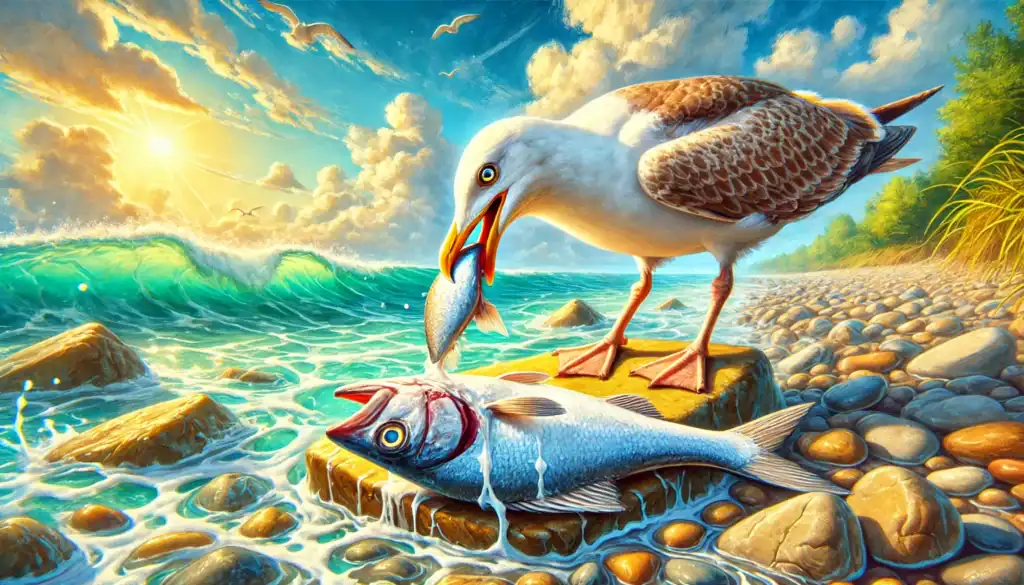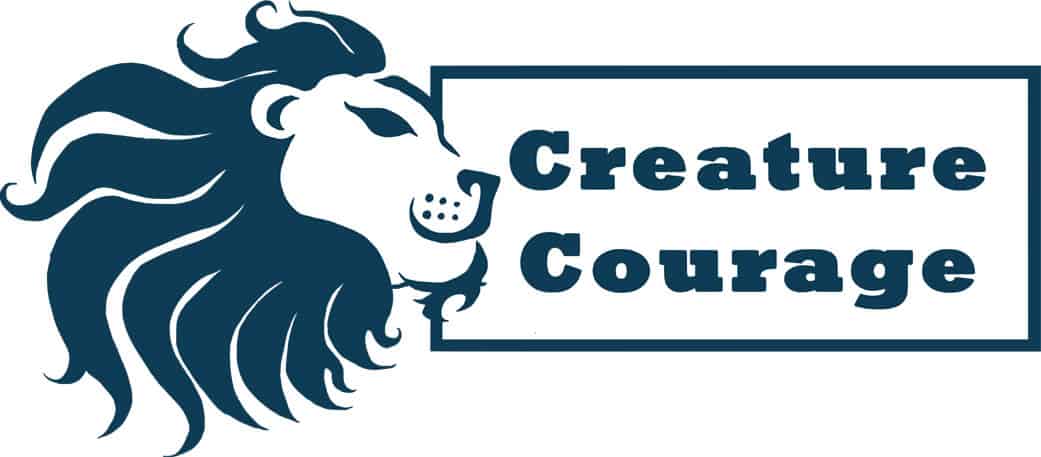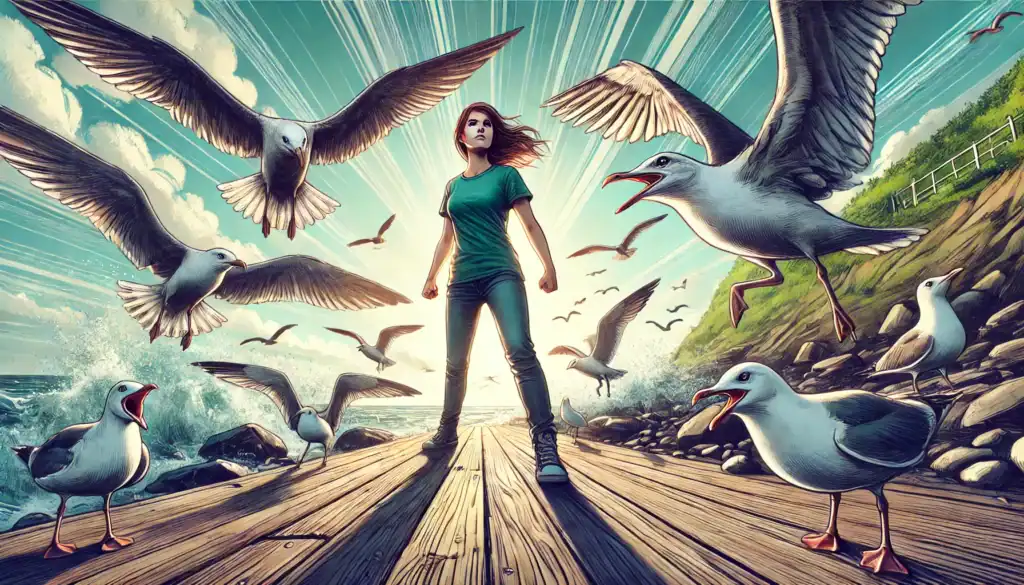Seagulls and Bird Phobias
Seagulls and other gull species are ubiquitous coastal birds, known for their distinctive calls and bold behaviour. For some, these birds evoke memories of glorious beach holidays and seaside adventures. For others, they trigger intense fear and anxiety. The fear of seagulls is known as laridophobia. Laridophobia may be a specific branch of ornithophobia, the fear of birds. It can also co-exist with other anxiety-related conditions like social anxiety or agoraphobia. This guide aims to shed light on gull behaviour, the phobia associated with them, and the ways we can use to overcome this fear.
What exactly are seagulls?
You might be surprised to learn that there isn’t actually a species of bird called the seagull but the term is actually colloquial for any many types of gull, including.
- Herring Gulls
- Black-headed Gulls
- Lesser Black-backed Gulls.
Indeed, gulls are not just found by the sea and their favourite food isn’t ice-cream and chips. Gulls can be found inland near large bodies of water and in urban areas, where it’s easy for them to come across discarded scraps. Ultimately gulls will go wherever food might be and adapt to the enviornment that provides it.

Why do some people fear seagulls?
Common reasons for gull phobia include:
- Aggressive food-snatching behaviour
- Loud, startling calls
- Large size and wingspan
- Tendency to flock in large numbers
- Media portrayals of “attacking” gulls
Signs of having a Seagull Phobia
People with a phobia of seagulls—known as laridophobia—may show a range of emotional and physical signs when near these birds or even when thinking about them. Common symptoms include intense anxiety, racing heartbeat, sweating, shortness of breath, and a strong urge to flee the area. Some individuals might avoid going to coastal towns, parks, or anywhere seagulls are likely to be present. In severe cases, even images or sounds of seagulls can trigger panic, nausea, or trembling. These reactions go beyond simple dislike or caution—they’re often irrational and overwhelming, significantly impacting a person’s ability to enjoy outdoor activities or holidays by the sea.
Is fear of seagulls common?
While a fear of gulls is not as prevalent as some other animal phobias, a fear of seagulls is not uncommon, especially in coastal areas. This fear can range from mild discomfort to intense panic at the sight or sound of gulls. If you’ve ever walked towards a flock of pigeons, in most urban centres, you’ll have an appreciation of how seagulls can cause trepidation and panic.
Why do seagulls sometimes seem so aggressive?

Gulls are opportunistic eaters. Although their diet is naturally focused around fish and molluscs, there is limited resource and a lot of competition. Humans have been depleting their natural source of food for centuries, especially in modern times creating a desperate situation. Therefore, gulls with easy access to urban environments are likely to try their luck where they can. They are not being deliberately aggressive to you but when food is scarce they may become bolder, which can be misinterpreted as aggressive. Most gulls will not hurt you at all, just steal your food. It’s only fair in a way! If you had starving children at home, you might get more bold as well.
Like most birds during nesting season, gulls become protective and will have limited tolerance of people, animals or other birds encroaching upon what they see as their territory (usually spring and summer).
Finally, the more we interact with them and feed them, then the more assertive gulls will become. Often we don’t realise the problems we are building up for ourselves. However, we must also take into account that we are depleting their natural food sources by over fishing our oceans. Seagulls are often left with no other choice but to steal food from humans as we have already stolen their food.
How can I live safely around seagulls?
- Don’t feed them human food: This encourages aggressive behaviour and dependency on human food. You can leave out healthy food like fish for them. However, only in places that are natural and not around humans.
- Secure your food: When eating outdoors, keep food covered and be aware of your surroundings.
- Maintain distance: Especially during nesting season, give gulls plenty of space.
- Stay calm: If a gull approaches, remain calm and move away slowly.
Exchanging Fear for Fascination: Unique Seagulls
- Adaptability: Gulls are hardy creatures and thrive in various environments, from coastal cliffs to city centres.
- Intelligence: They’re known for their problem-solving abilities and learning complex behaviours. A research study by the University of Sussex found that herring gulls can learn from watching us eat and choose what to target and when to get the best meal.
- Friendly! They can also learn which humans are friendly and not so friendly! Many people have made friends with wild gulls, earning their trust. They can actually bring a lot of joy to people. Watch this incredible video of a woman making friends with a seagull.
- Longevity: Most species live for much longer within captivity than in the wild but some gull species can live up to 30 years in the wild!
- Diet: As we’ve discussed, gulls are opportunistic feeders, eating everything from fish to human food scraps. If they are given the opportunity to feed they are unlikely to pass it up, whether that’s a gull’s natural diet of seafood, birdseed or an unattended box of chips.
Excellent Parents
seagulls are very attentive and protective mothers, often going to great lengths to care for and defend their young.
Female seagulls typically lay two to three eggs in a carefully built nest, which they often line with grass, feathers, or other soft materials. Both parents take turns incubating the eggs for around three to four weeks, showing a strong sense of cooperation and commitment to their offspring. Once the chicks hatch, mother seagulls (alongside the fathers) are highly nurturing—feeding their young regurgitated food and keeping them warm and safe.
One of the most striking signs of their parental instinct is how fiercely they defend their nests. During breeding season, seagulls can become quite aggressive—not out of malice, but out of a deep instinct to protect their vulnerable chicks from perceived threats, including humans. This behaviour, often misinterpreted as “attacking,” is actually a sign of their strong maternal bond and survival instinct. Lots of other creatures are keen to eat their young, so they must be vigilent and brave.
Understanding that seagulls are simply caring for their families can help build empathy. Like many wild animals, they’re doing their best to raise their young in an increasingly human-dominated world. When viewed through a compassionate lens, their boldness is not something to fear—but something to admire.

Why Seagulls Are Important for the Environment
While seagulls are often seen as noisy or aggressive, especially in urban or coastal areas, they play a vital role in maintaining the health and balance of the ecosystems they live in. Seagulls are natural scavengers, which means they help clean up food waste and organic matter that might otherwise attract pests or spread disease. By consuming discarded food, dead animals, and other debris, seagulls act as a form of nature’s clean-up crew, reducing environmental pollution both in towns and along the shoreline.
Seagulls also contribute to the balance of marine and coastal ecosystems. They control populations of insects, fish, and small animals, helping to prevent overpopulation and maintain biodiversity. Their droppings may seem unpleasant, but they serve a purpose too—seagull poo can help fertilise soil and disperse seeds, supporting plant growth in areas they frequent. Their nesting habits—even when inconvenient to humans—also support the food chain, as their eggs and chicks provide nourishment for other wildlife species. In many ways, seagulls are a vital link in the delicate web of coastal life, silently performing functions that benefit the entire ecosystem.
Understanding the role seagulls play in nature can help shift fear into compassion. These birds are simply trying to survive in environments that humans have drastically changed. Urban development, overfishing, and waste mismanagement have altered their natural behaviours, often forcing them into closer contact with people. By recognising their value and the challenges they face, we can begin to see seagulls not as pests, but as adaptable survivors—creatures deserving of respect, not fear

How to Deal with Panic When Encountering a Seagull
1. Take Slow, Deep Breaths
When fear kicks in, your breathing can become shallow and fast. Try to slow it down with deep belly breaths—in for 4 seconds, hold for 4, out for 6. This signals your body that you are safe and helps reduce panic.
2. Ground Yourself Using the 5-4-3-2-1 Technique
Shift your focus away from the seagulls by naming:
5 things you can see
4 things you can touch
3 things you can hear
2 things you can smell
1 thing you can taste
This helps anchor your mind in the present moment and calms racing thoughts.
3. Put Physical Space Between You and the Birds
If possible, calmly step away from the area without running. Seagulls are less likely to approach if you’re not eating or directly interacting with them. Move indoors, into a car, or to a quieter spot if needed.
4. Avoid Eye Contact and Sudden Movements
Seagulls are observant, and staring at them or making quick gestures can seem threatening. Keep your posture relaxed, avoid direct eye contact, and don’t wave your arms.
5. Use Positive Self-Talk
Remind yourself: “I am safe. The bird is not attacking me. This feeling will pass.” Calming inner dialogue helps interrupt spiralling thoughts and reinforces that your fear, while real, doesn’t control you.
6. Fake it Until You Make It
Even if you’re scared inside, try pretending to be calm and in control. Standing tall, breathing steadily, and moving confidently can actually trick your brain into feeling safer. Over time, these ‘fake’ behaviours can build real resilience.
How can I overcome my fear of seagulls?
- Education: Learn about gull behaviour and ecology to demystify these birds with the aim to build fascination and compassion. The more curious and empathetic you feel towards seagulls, the less you will fear them.
- Gradual exposure: Start with pictures or videos, then progress to observing gulls from a safe distance and get closer and closer to show your survival part of your brain there is no real threat.
- Mindfulness techniques: Practise deep breathing and grounding exercises when encountering gulls.
- Cognitive Behavioural Therapy (CBT): Work with a therapist to challenge and change negative thought patterns about gulls.
- Seek specialised help: Organisations like Creature Courage offer targeted therapy for animal phobias.
What if My Fear of Seagulls is Impacting My Daily Life?
- Recognize that your fear is valid, but also treatable.
- Consider reaching out to Creature Courage for professional help in overcoming your phobia, after all, it’s just a conversation to start.
- Remember that with the right support and techniques, you can learn to coexist peacefully with gulls.
A Life Of Freedom with Creature Courage

Seagulls and other gulls are fascinating, adaptable birds that play important roles in both natural and urban ecosystems. While fear of these birds is understandable, it doesn’t have to limit your enjoyment of coastal areas or outdoor spaces. With education, patience, and the right support, you can transform your fear into understanding and even appreciation for these remarkable birds.
If you’re struggling with a fear of seagulls, Creature Courage offers compassionate, evidence-based support to help you overcome your phobia. Using a combination of Cognitive Behavioural Therapy (CBT), gradual exposure techniques, and mindset coaching, Creature Courage helps individuals build confidence and reduce anxiety around seagulls in a safe and supportive way. Whether your fear stems from a past experience or general anxiety about birds, their expert-led sessions are tailored to your unique needs and comfort level. With a proven track record of helping people overcome animal phobias, Creature Courage empowers you to reclaim your freedom—so you can enjoy coastal visits, parks, and everyday life without fear.
If you’re ready to take the first step towards overcoming your fear of seagulls, don’t hesitate to reach out to Creature Courage. Their specialised approach to animal phobias can help you develop the tools and confidence to enjoy the seaside, parks, and other outdoor spaces without anxiety. Remember, freedom from your fear is possible, and it starts with that first brave step.

FAQ About Fear of Seagulls
1. What is the fear of seagulls called?
The fear of seagulls is known as laridophobia. It’s a type of specific phobia that can cause anxiety, panic, or distress when encountering seagulls in real life or even in pictures or videos.
2. Why am I so scared of seagulls?
People often develop a fear of seagulls due to negative past experiences, such as being attacked for food, startled by loud calls, or seeing aggressive behaviour. In some cases, the fear may stem from a general anxiety disorder or a fear of birds (ornithophobia).
3. Is it normal to be afraid of seagulls?
Yes, it’s more common than you might think. Many people in coastal areas or cities where seagulls are bold and food-aggressive develop a fear over time. It becomes a phobia when the fear is intense and interferes with daily life.
4. Can seagulls be dangerous?
Seagulls are generally not dangerous, but they can act aggressively if they feel threatened or are protecting their chicks. Some seagulls have learned to steal food from humans, which can feel intimidating but rarely causes physical harm.
5. How can I overcome my fear of seagulls?
Overcoming a fear of seagulls may involve gradual exposure, CBT (Cognitive Behavioural Therapy), relaxation techniques, or professional therapy. Understanding their behaviour can also help reduce fear by replacing anxiety with knowledge.
6. Are there therapies for fear of seagulls in the UK?
Yes, there are therapists in the UK who specialise in treating phobias, including fear of birds. Creature Courage is the leading animal phobia specialist and are a great place to start.
7. Do seagull attacks happen often in the UK?
Seagull attacks are relatively rare but can seem common in certain areas during the breeding season (May to July). Most “attacks” involve swooping or stealing food rather than physical injury.
8. Why do seagulls dive at people?
Seagulls dive at people mostly to protect their nests or chicks, or when trying to grab food. This is typical territorial behaviour and isn’t meant to be harmful, although it can be frightening.
9. Can I avoid seagulls while at the seaside?
While you can’t completely avoid them, you can reduce encounters by not eating openly, avoiding nesting areas, and keeping your distance. Many seaside towns also have signage with safety tips for dealing with seagulls.
10. Is fear of seagulls linked to other bird phobias?
Yes, laridophobia may be a specific branch of ornithophobia, the fear of birds. It can also co-exist with other anxiety-related conditions like social anxiety or agoraphobia.


